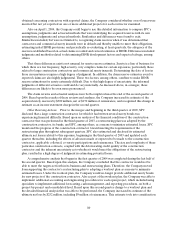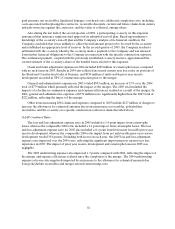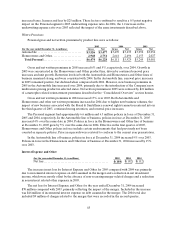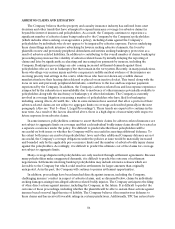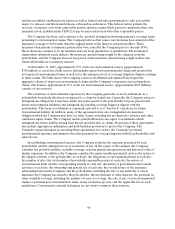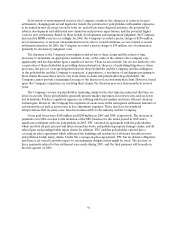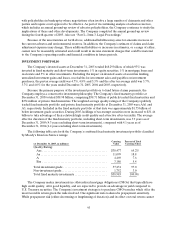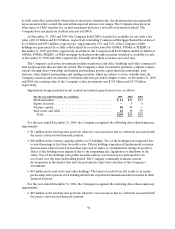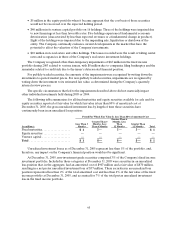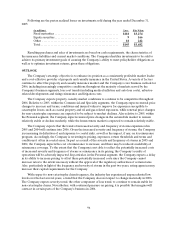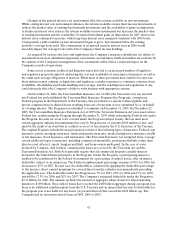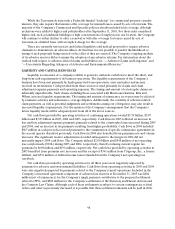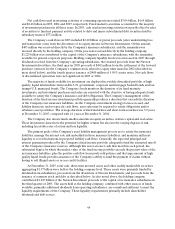Travelers 2005 Annual Report Download - page 102
Download and view the complete annual report
Please find page 102 of the 2005 Travelers annual report below. You can navigate through the pages in the report by either clicking on the pages listed below, or by using the keyword search tool below to find specific information within the annual report.90
and later modified, enables private parties as well as federal and state governments to take action with
respect to releases and threatened releases of hazardous substances. This federal statute permits the
recovery of response costs from some liable parties and may require liable parties to undertake their own
remedial action. Liability under CERCLA may be joint and several with other responsible parties.
The Company has been, and continues to be, involved in litigation involving insurance coverage issues
pertaining toenvironmental claims. TheCompany believes that some court decisions have interpreted the
insurance coverage to be broader than the original intent of the insurers and policyholders. These
decisions often pertain to insurance policies that were issued by the Company prior to the mid-1970s.
These decisions continue to be inconsistent and vary from jurisdiction to jurisdiction. Environmental
claims whensubmitted rarely indicate the monetary amount being sought by the claimant from the
policyholder, and the Company does not keep track of the monetary amount being sought inthose few
claims which indicate a monetary amount.
At December 31, 2005, approximately 75% of the net environmental reserve (approximately
$318 million) is carried in a bulk reserve and includes unresolved environmental claims and incurred but
not reported environmental claims as well as for the anticipated cost of coverage litigation disputes relating
to these claims. The bulk reserve the Company carries is established and adjusted based upon the
aggregate volume of in-process environmental claims and the Company’s experience in resolving those
claims. The balance, approximately 25% of the net environmental reserve (approximately $107 million),
consists of case reserves.
The resolution of environmental exposures by the Company generally occurs by settlement on a
policyholder-by-policyholder basis as opposed to a claim-by-claim basis. Generally, the Company strives to
extinguish any obligations it may have under any policy issued to the policyholder for past, present and
future environmental liabilities and extinguish any pending coverage litigation dispute with the
policyholder. This form of settlement is commonly referred to as a “buy-back” of policies for future
environmental liability. In addition, many of the agreements have also extinguished any insurance
obligation which the Company may have for other claims, including but not limited to asbestos and other
cumulative injury claims. The Company and its policyholders may also agree to settlements which
extinguish any future liability arising from known specified sites or claims. Provisions of these agreements
also include appropriate indemnities and hold harmless provisions to protect the Company. The
Company’s general purpose in executing these agreements is to reduce the Company’s potential
environmental exposure and eliminate the risks presented by coverage litigation with the policyholder and
related costs.
In establishing environmental reserves, the Company evaluates the exposure presented by each
policyholder and the anticipated cost of resolution, if any. In the course of this analysis, the Company
considers the probable liability, available coverage, relevant judicial interpretations and historical value of
similar exposures. In addition, the Company considers the manyvariables presented, such as the nature of
the alleged activities of the policyholder at each site; the allegations of environmental harm at each site;
the number of sites; the total number of potentially responsible parties at each site; the nature of
environmental harm and the corresponding remedy at each site; the nature of government enforcement
activities at each site; the ownership and general use of each site; the overall nature of the insurance
relationship between the Company and the policyholder, including the role of any umbrella or excess
insurance the Company has issued to the policyholder; the involvement of other insurers; the potential for
other available coverage, including the number of years of coverage; the role, if any, of non-environmental
claims or potential non-environmental claims, in any resolution process; and the applicable law in each
jurisdiction. Conventional actuarial techniques are not used to estimate these reserves.


